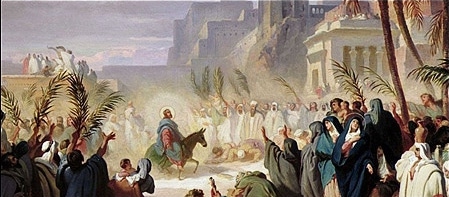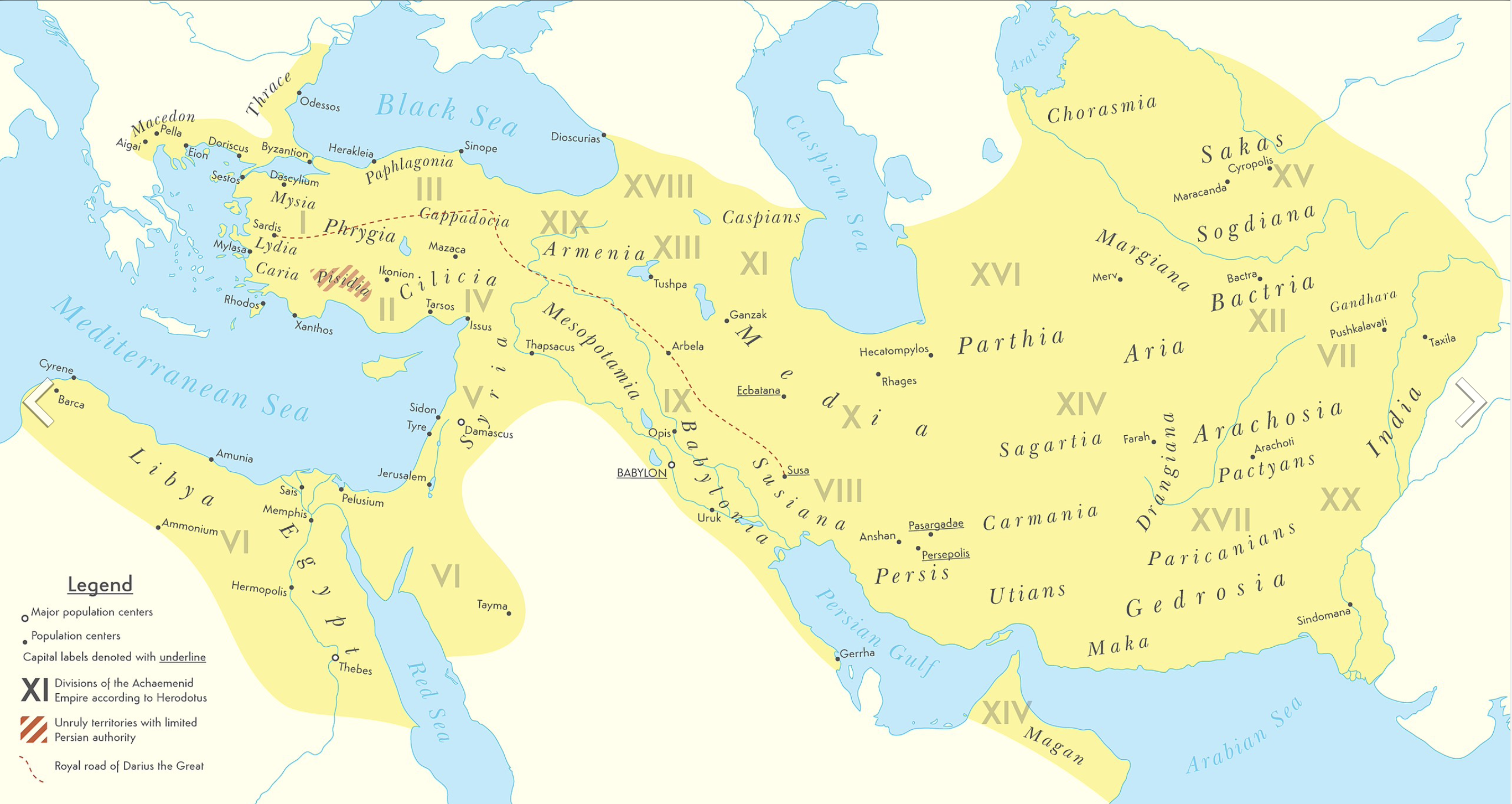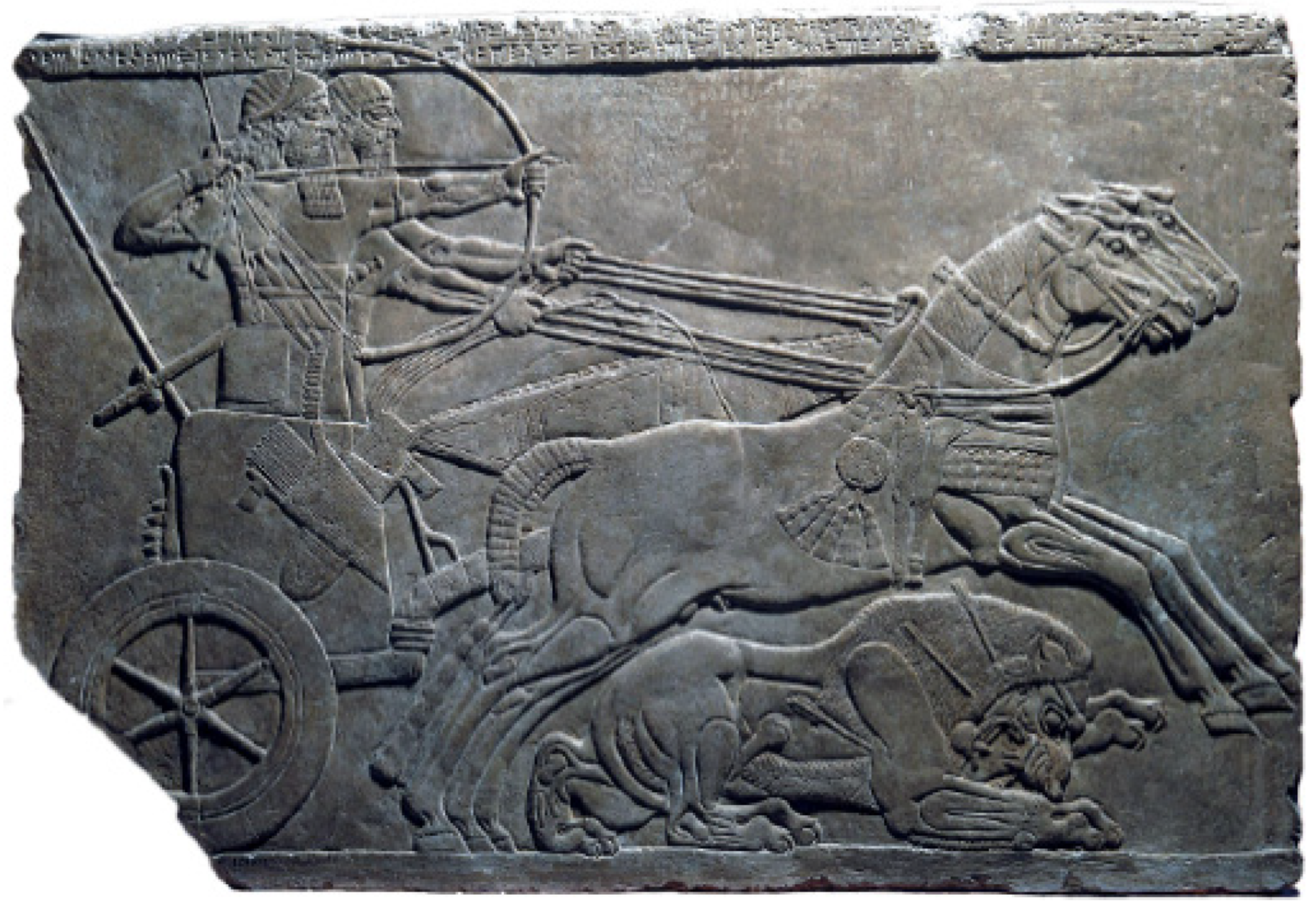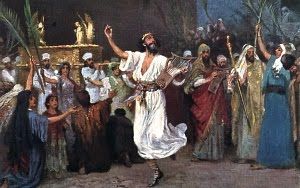

"Palm Sunday" in the West is a time of confusion and emotional turmoil. The people process around their churches with blessed palms exclaiming, "Hosanna, Hosanna in the highest!" Jerusalem also seems to be turning out in that same spirit proclaiming Jesus to be King. Then, suddenly, we are all plunged into darkness. Our King is degraded, spitted on, scourged, publicly mocked, and finally murdered. Homilies in the West center on the fickleness of the people. Pilate asks, "Don't you want your king?" The people reply, "Crucify Him!" "Give us Barabbas!"
We are left, especially as children, with the impression that finally everything was going right .... Jesus is proclaimed "king," but then something has happened to throw everything into chaos.
Orthodox Christians have been formed in a different conception of this day. known simply as "Entry of the Lord into Jerusalem." This may seem incredible to Christians in the West. Are we not reading the same Bible? Have not these same events transpired? Yes, this is so. But what we see has everything to do with what we are looking for. Our expectations form a kind of lens. We ignore details we deem irrelevant however unconsciously. Many of us pass over the footnotes of historical background as more "irrelevancy." And we stay with our map of our expectations, which has been drawn for us by our culture.
At the outset a different lens is selected by the Orthodox Church for its faithful, choosing the Gospel of St. John the Theologian, the greatest teacher in Orthodoxy (after the Master Himself) to gloss this great feast:
|
Therefore the people, who were with Him when He called Lazarus
out of his tomb and raised him from the dead, bore witness. For this reason the people also met Him, because they heard that He had done this sign. (Jn 12:17-18) |
.... a different focus altogether.
This commentary on Lazarus serves to explain the crowds that had come to Jerusalem. For here is the man who raised Lazarus from the dead! What will He do next?! Lazarus' body was already overtaken with rot! Yet He raised him from the dead
But many other, the Jews (St. John said), had come to execute a conspiracy to murder Lazarus in order to nullify Jesus' Divine power. Rewriting history .... you know, that's as common as dirt.
|
Now a great many of the Jews knew that He was there; and they came,
not for Jesus' sake only, but that they might also see Lazarus, whom He had raised from the dead. But the chief priests plotted to put Lazarus to death also, because on account of him many of the Jews went away and believed in Jesus. (Jn 12:9-11) |
As an aside we must remember that this phrase the Jews is rarely mentioned by the Apostles. The Twelve Disciples are Hebrews, not Jews .... except one Disciple, named after the tribe of Judah, Iscariot. St. John uses the term "Jews" sixty-six times and always to refer to a socio-political party in Judea who practice Mesopotamian religion. It is significant, therefore, that Jesus riding in procession into city is called the "prophet from Nazareth" answering the question, "Who do you say that I AM?" That is, the crowds standing near Mount Zion understand Him to be a Hebrew — the One bearing the mantle of the ancient religion.
All of this is distinctly laid out for the reader .... if only we had the lenses to discern them.
This commentary on Lazarus frames the very few words written to describe Jesus' procession. And we do not strain to say that this Gospel passage is more focused on Lazarus than it is upon Jesus.
"How odd!" said one of the Hermitage sisters. "How odd to bring up the raising of Lazarus at this great moment in Jesus' life!" And that ought to be the Western response — we who have read the other Gospels on this day for so many years. In the West we always read the Synoptic Gospels for this feast day. You see, the camera of attention is focused on palms, on clothing being laid in the path of the Lord's donkey, and on the exultant shouts of Hosanna in the highest.
To understand these differences,
let us set a wider scene.
And I do not mean the first-century scene,
for that is not the scene that Jesus insists upon.
The Master conspicuously refers back to a scene from the seventh-century B.C.,
the century in which Judah-ism was imported from Babylon.
And He does this with uncharacteristic precision.
The man who speaks in parables and riddles now speaks with unusual exactitude.
According to the Gospel of St. Matthew,

|
Now when they drew near Jerusalem, and came to Beth-phage,
at the Mount of Olives, then Jesus sent two disciples,
saying to them,
"Go into the village opposite you, and immediately you
will find a donkey tied, and a colt with her. Loose them
and bring them to Me. And if anyone says anything to you,
you shall say, 'The Lord has need of them,' and immediately
he will send them."
All this was done that it might be fulfilled which was spoken by the prophet, saying: "Tell the daughter of Zion, 'Behold, your King is coming to you, Lowly, and sitting on a donkey, A colt, the foal of a donkey.'" So the disciples went and did as Jesus commanded them. They brought the donkey and the colt, laid their clothes on them, and set Him on them. And a very great multitude spread their clothes on the road; others cut down branches from the trees and spread them on the road. Then the multitudes who went before and those who followed cried out, saying: "Hosanna to the Son of David! 'Blessed is He who comes in the name of the Lord!' Hosanna in the highest!" And when He had come into Jerusalem, all the city was moved, saying, "Who is this?" So the multitudes said, "This is Jesus, the prophet from Nazareth of Galilee." (Mt 21:1-11) |
We have read this passage so many times yet never fully understood it.
You see, Jesus enacts a carefully laid out plan down to every detail .... which no one around Him understands, as the detail concerning two donkeys reveals — Matthew says, "They brought the donkey and the colt, laid their clothes on them and set Him" on two animals! But Jesus had correctly cited Zechariah: "a donkey / even the foal of a donkey" (the word for and is an intensive form in both Greek and Latin). This is to emphasize the animal's lowliness: not the full-grown donkey, but its more humble foal .... "even the foal!"

Meantime, the historical backdrop for Zechariah's prophecy
is
dark
thunderheads rolling in from the northeast,
a ruinous storm and a leveling wind
—
for this is
the great crossroads of Hebrew history,
much greater than the Exodus.
To quote Prof. Yehezkel Kaufmann of the Hebrew University in Jerusalem,
|
"The exile is the watershed. With the exile, the religion of Israel
comes to an end, and Judaism begins." |
The Neo-Babylonians had dominated the Levant taking a third of the Judean elite to Babylon for two generations. This so-called Babylonian Captivity ended as the Neo-Babylonians were overtaken by a far greater power, the Persians. Both were Mesopotamian. Both practiced animal sacrifice. (From the Hebrew point of view, this was a distinction without a difference.) Both worshipped idols requiring blood sacrifice. Both forbade the ancient religion given at Mt. Sinai, practiced under Kings David and Solomon, which Jesus represents riding into the city.
The passage from Zechariah cited by Jesus is preoccupied with this pervasive idolatry:

|
For Tyre built herself a tower,
Heaped up silver like the dust, And gold like the mire of the streets. Behold, the Lord will cast her out; He will destroy her power in the sea, And she will be devoured by fire .... And I will cut off the pride of the Philistines. I will take away the blood from his mouth, And the abominations from between his teeth. that He had done this sign. (Zech 9:3-4,7) |
In the midst of this, says Zechariah, the Lord appears in His aspect of King:
|
"Rejoice greatly, O daughter of Zion!
Shout, O daughter of Jerusalem! Behold, your King is coming to you; He is just and having salvation, Lowly and riding on a donkey, [Nay!] a colt, the foal of a donkey. I will cut off the chariot from Ephraim And the horse from Jerusalem; The battle bow shall be cut off." (Zech 9:9-10) |
We include with our posted reflection today an engraving from precisely these years depicting the ancient Persians in their proud chariots pulled by many horses and bearing their great battle bows. The blood in the mouth of the Philistine and the abominations between his teeth invoke the ritual of animal sacrifice.
The Lord's royal progress through the Gates of Jerusalem, which we observe today, reprises the scene from Zechariah exactly. The figure riding upon the lowly foal of the donkey is God. He will cut off the trappings of the Persians (and their like) from Jerusalem — the chariot, the horse, the battle bow. He will remove the abominations from between the teeth of the Jewish priests. And root out animal sacrifice from the Temple as his riotous demonstration with a whip had prefigured. Indeed, He has said He will destroy this temple (Jn 2:19), this Mesopotamian temple. By extension, He will set at naught the pomp and glory of Rome, who like the Neo-Babylonians and Persians are still proud in their chariots and tall horses processing through arches of triumph and victory. And He will do all this by .... being God.
What the One riding the donkey's foal carries with Him into Jerusalem, in Zechariah's original, is Himself, which, in practical terms, means the restoration of intimacy with Him, true religion amidst Mesopotamian abominations. This is the primary text for the Hebrews — the ones who did not become Jews. After all, two-thirds of the population were not carried off to Babylon. They remained in the Land of Promise. They continued to practice the ancient Hebrew religion. For them the Neo-Babylonian catastrophe was the looting of Solomon's Temple and the disappearance of the Ark of the Lord, of Aaron's rod, of the manna in the jar, and of the anointing oil (which was reprised in our Gospel reading this morning).
We can easily imagine their emotions as their exiled brethren returned speaking Mesopotamian language (Aramaic), practicing Mesopotamian religion (blood sacrifice), building a temple (underwritten and supervised by Mesopotamians), and revising the Sacred Scriptures to accommodate Mesopotamian values.
Small wonder that a large proportion of the Hebrew population, seeing these bizarre developments, fled to begin again in a new Promised Land. They founded a colony in the south of Egypt on an island called Elephantine. The temple they built there in 525 B.C. followed the worship of Solomon's Temple as best they could. When the Persian King Darius heard of it, he issued an edict in 419 BC ordering the Hebrews to practice animal sacrifice in their temple.
The disgusting idea of mauling terror-stricken animals
in order to spray blood on an altar
deeply offended the Egyptians.
In their rage, they destroyed this Hebrew-cum-Persian temple,
where the scene of gentle communion with God
had devolved into
a stench-filled slaughterhouse.
And
Whom do we picture in this scene?
Is not the Lord Jesus who overturned tables that had animals on them
whipping those who would carry forth with the cult of animal sacrifice?
We have said that the primary subtext for today's feast is the Book of Zechariah.
Of greater importance is Zechariah's primary subtext,
which is
the Second Book of Samuel,
depicting another procession,
the original procession of God-as-King into Jerusalem:

| Again David gathered all the choice men of Israel, thirty thousand. And David arose and went with all the people who were with him from Baale Judah to bring up from there the Ark of God, whose name is called by the Name, the Lord of Hosts, Who dwells between the cherubim. So they set the Ark of God on a new cart, and brought it out of the house of Abinadab, which was on the hill; and Uzzah and Ahio, the sons of Abinadab, drove the new cart. And they brought it out of the house of Abinadab, which was on the hill, accompanying the Ark of God; and Ahio went before the Ark. Then David and all the house of Israel played music before the Lord on all kinds of instruments of fir wood, on harps, on stringed instruments, on tambourines, on sistrums, and on cymbals .... So David went and brought up the Ark of God from the house of Obed-Edom to the City of David with gladness. And so it was, when those bearing the Ark of the Lord had gone six paces, that he sacrificed oxen and fatted sheep. Then David danced before the Lord with all his might; and David was wearing a linen ephod. So David and all the house of Israel brought up the Ark of the Lord with shouting and with the sound of the trumpet. (2 Samuel 6:1-6, 12-16) |
Let us pause to note a Mesopotamian insertion in this text. The high pitch of unconfined joy, spontaneity, and music is halted .... so that oxen and sheep can be sacrificed and then put away again. And then the off-switch is turned on again, and then everybody returns to the same high pitch of excitement playing every kind of instrument and dancing with all their might ... as if spontaneity like this can be turned on and off.
It does not take a literary genius to discern that this pause, interrupting this high point of excitement and celebration, is simply an insertion into the original text. You see, the Neo-Babylonians cannot have a Second Book of Samuel depicting this most important .... without objecting, "Where's the animal sacrifice? We must have animal sacrifice before the Lord!" And here we must remember that the pagan idol Baal means "Lord" in its native language.
We know this human response. The people fear being "canceled." "The thought police will be coming down here. We'd better insert a few words about animal sacrifice." We must understand that the Sacred Scriptures were revised in Babylon. They were edited. Without this realization we cannot understand what Jesus represented as He rode into the City of David.
On this day, our holy feast day, we actually celebrate the third entrance of God into Jerusalem — God Present in the Ark of the Lord, God Present in the mouth of His holy prophet, and God Incarnate riding the foal of a donkey. In splendid aloofness, He will tell Caesar's viceroy that His Kingdom is not of this world. Most important from our perspective, He has come to restore Himself to us, which we call "religion," our intimacy with Him. Does He not call us His friends (Jn 15:14)? Does He not refer to us as His adopted family (Mk 3:34). For this was the religion of King David, the anointed one: the religion of personal transformation, ritualized in the Holy of Holies, revealed on the Mount of Transfiguration, and carried forward into Christian life by the original ancient Catholic Church, which we call Orthodoxy.
The Second Temple, Mesopotamian temple, would be destroyed as He said. But the religion ordained by God on Mount Sinai and confirmed by His Only-begotten Son, is established for all as the rent in the veil into the Holy of Holies would signify. It is open to you to enter into the fullness of the God-Man and everyone.
And what do the people proclaim as our Our Lord enters the City of David?
| "Blessed is He Who comes in the Name of the Lord!" (John 12:13) |
This is the cry that is sent up for the transformed one about to enter the Holy of Holies, signifying the fullness of theosis — union with the Divine, citizenship in the Kingdom of Heaven. This is what we celebrate on the holy day now upon us: the Entry of God into the City of David.
And here we have come to understand why the primary subject should be Lazarus at this all-important moment. For theosis is a process through which our material selves are cast off, and our Divine souls are magnified. This is the whole art of purification: to rid ourselves of the fleshly, the material, and the carnal. To all Palestine, Lazarus is the great victor in this battle, by the grace of God. For death is the great test of our carnality. In the end have we committed our souls to carnal life, or we have committed ourselves in bonds of love to God. We cannot have both: indeed, the one is eternally the implacable enemy of the Other. It is not for nothing that the chief agency on earth pulling us into carnal life are demons.
In Lazarus we see the fullness of theosis. The stink of fleshly life as been leached out of him. He has risen like a phoenix from that body. His tomb has been transformed into an Holy of Holies. He has risen above the towers of pride and carnality, from the very heart of Hell.
As our Savior and King enters the Royal City, He sets within her heart once again the high promise, given to David, of Divine intimacy and Divine transformation. May the Lord be with you! This is our dearest and most cherished hope. This is His gift on Palm Sunday: Himself, Which He prays, is us, redeemed, transformed, and One with Him.
Ride on, ride on in triumph.
Ride on, like Lazarus, in victory.
In the Name of the Father and of the Son and of the Holy Ghost. Amen.